Electrical Energy as Free as the Wind
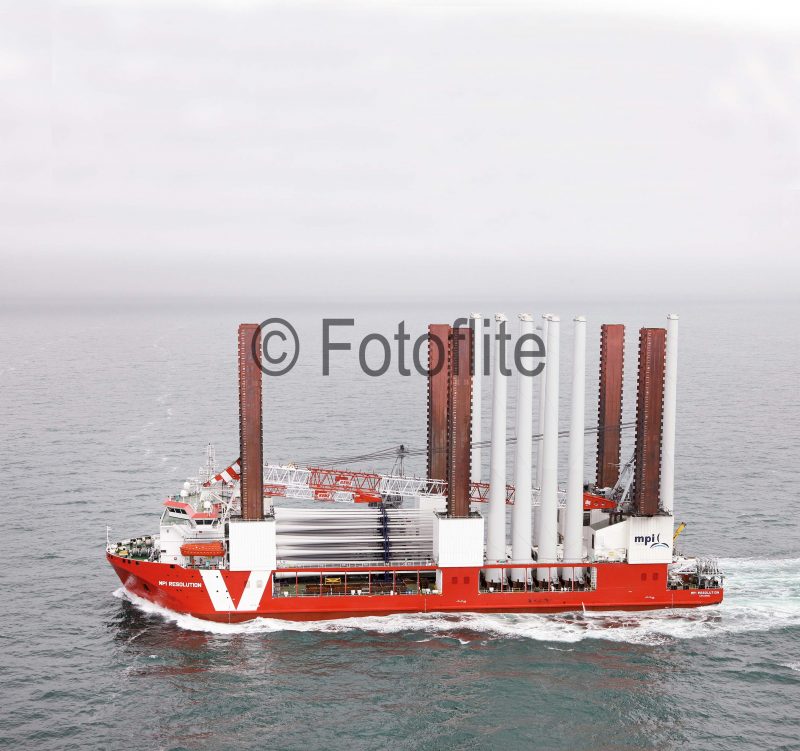
Renewable green energy in the form of wind, solar or tidal power has the very great potential of providing one quarter of all U.K. daily electricity requirements. This target was attained on a number of summer days in 2017, with the great advantage of a big reduction in the burning of fossil fuels. The U.K. is well ahead of most countries in the number of onshore and offshore wind farms, with the planning process for offshore wind farms (OWF) easier to procure in British shallow coastal waters. It is now two decades since the installation of the first U.K. offshore wind farm, and the U.K. now has the largest OWF in the world in the London Array in the outer Thames Estuary of 175 turbines and 630 megawatts of power. The top dozen U.K. OWFs all generate power outputs of between 300 megawatts and 600 megawatts of electricity. There are now eighty OWFs in commission, under construction or in the planning process for U.K. coastal waters. Germany has the 97 turbine 582 megawatt Gode Wind Farm to the north west of Norderney in the North Sea, Holland has the 150 turbine 600 megawatt Gemini Wind Farm to the north of the Frisian Islands, and Denmark has the 111 turbine 400 megawatt Anholt Wind Farm in the Kattegat near Anholt Island, as well as other wind farms off Esbjerg.
Wind turbine installation vessels (WTIV) are now common sights around all U.K. coasts, with offshore wind farms concentrated in the shallow coastal waters of the East Coast or the Irish Sea. A WTIV is specially designed for the positioning and setting up of offshore wind turbines, and has borrowed the jack-up technology of the offshore oil industry as regards self elevation. It is self propelled to enable fast relocation to the next wind farm, and has a well designed hull of sufficient width to carry multiple foundations, towers, nacelles and blades. Azimuth propellers with DP2 positioning computer systems are used to accurately position the vessel during the jack-up operation. The long wind turbine towers of length eighty metres are usually transported by the WTIV in the upright position and bolted to a vertical stay in order to ease the lifting of towers of up to one hundred metres in height to fit into the yellow Transition Pieces (TP) already sunk into foundations or monopiles on the seabed. Foundation monopiles typically weigh 800 tonnes, towers can weigh 300 tonnes, nacelles can weigh 330 tonnes, and blades or rotors can weigh 150 tonnes with a 126 metre diameter. The WTIV operations are thus essentially heavy lift operations performed during calm weather windows in shallow waters with legs planted firmly into the seabed. Sheerleg and jack-up barges and other similar craft were used at first before the lack of WTIVs was remedied from 2003 onwards.
Mayflower Resolution
This was the first U.K. WTIV and was named after the collier brig of Capt. James Cook that he used in his later world exploration voyages. She jacked-up her initially white painted hull on her six legs between three metres (ten feet) and 46 metres (151 feet) above the sea. She was launched in 2003 at the Shanhaiguan yard in Qinhuangdao in China (Yard number TIV1) and was completed in November of that year for Mayflower Energy Ltd. and is registered at Douglas in the Isle of Man. She has dimensions of length 130.5 metres, moulded beam of 38.0 metres and depth of 8.0 metres with a draft of 4.0 metres. She is powered by four Mitsubishi sixteen cylinder four stroke oil engines driving four generators, each of 1,824 kW and connected to four electric motors, each of 1,500 kW, and four Aquamaster azimuth thrusters for propulsion and steering to give a total power output of 9,000 bhp and a service speed of 10.5 knots. She is also equipped with three 700 kW Kamewa bow thrusters for accurate positioning of the vessel in conjunction with her Kongsberg Simrod SDP11 dynamic positioning computer control system. There is a manual override for this system using an independent joystick control system in the event of the computer system becoming inoperable.
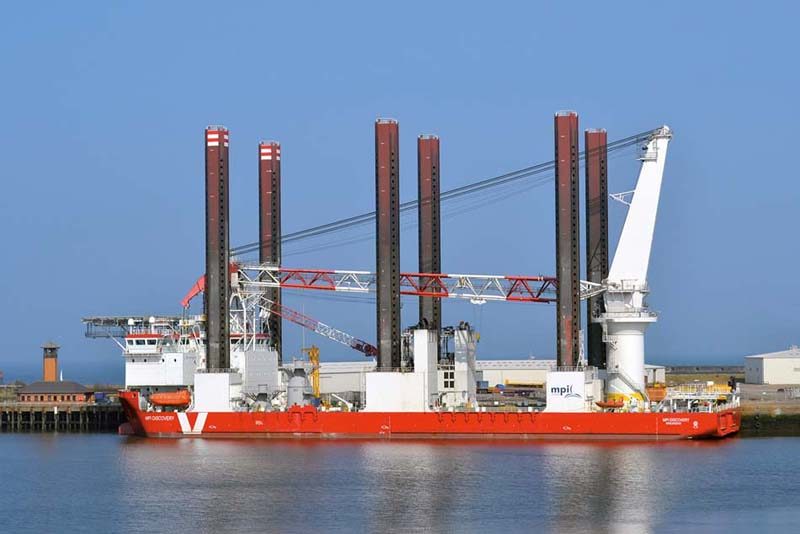
Mayflower Resolution has a height of 226.2 feet at a draft of 9.5 feet, with a maximum payload of 8,950 tonnes, 3,800 square yards of cargo area, and one pedestal mounted rope luffing electric/hydraulic crane of 300 tonnes capacity at 25.5 metre radius, with another crane of fifty tonnes capacity at a radius of 35 metres. She has a ballast capacity of 8,832 cubic metres in thirteen tanks, with twin two speed ballast pumps of one thousand cubic metres per hour capacity. She has a cylinder type jacking system with each leg handled by four primary and four secondary cylinders. These are retained in position by catch beams, which are housed in catch beam rings attached to the jacking cylinders. The jacking system elevating capacity is 2,500 tonnes per leg and the holding capacity is 5,000 tonnes per leg.
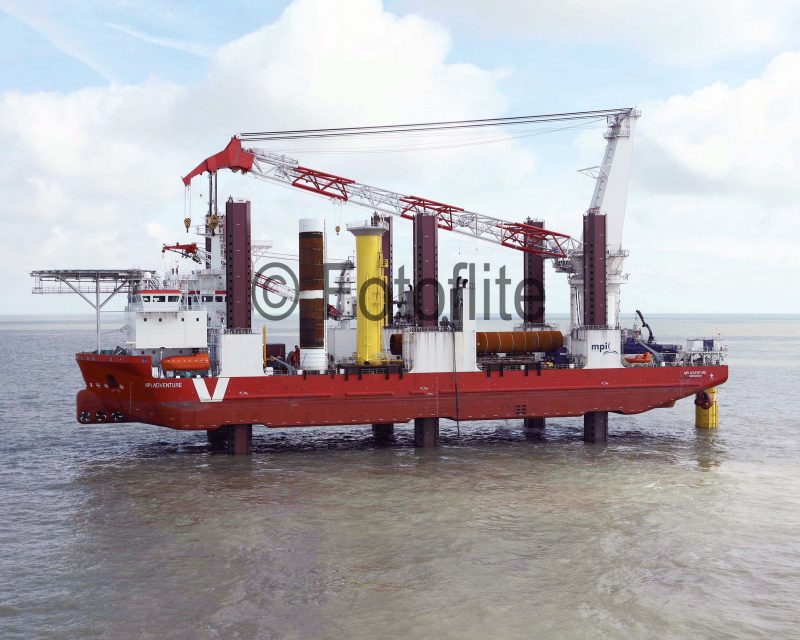
Mayflower Resolution was the first and largest WTIV in service and was designed by the Knud E. Hansen (KEH) practice of Denmark with her construction supervised by Graig Shipping of Cardiff, and she is known as the ‘mother of all WTIVs’. She is equipped with the very latest dual radar systems, VHF systems, Inmarsat B and C communications systems, independent Sperry autopilot and echosounder, Litton water speed Doppler log unit, and two independent GPS systems to constantly monitor her position. She has a gross tonnage of 14,310 and cost £53 million to build, although her contract price was £20 million, which was exceeded by £10 million by the shipyard, with a further £23 million spent in adding an ROV (Remotely Operated Vehicle) system to enable her to lay undersea cables as well as install wind turbines. She has a crew of 34 with the turbine erection team of 36 people swelling her complement to seventy persons, all housed in single cabins.
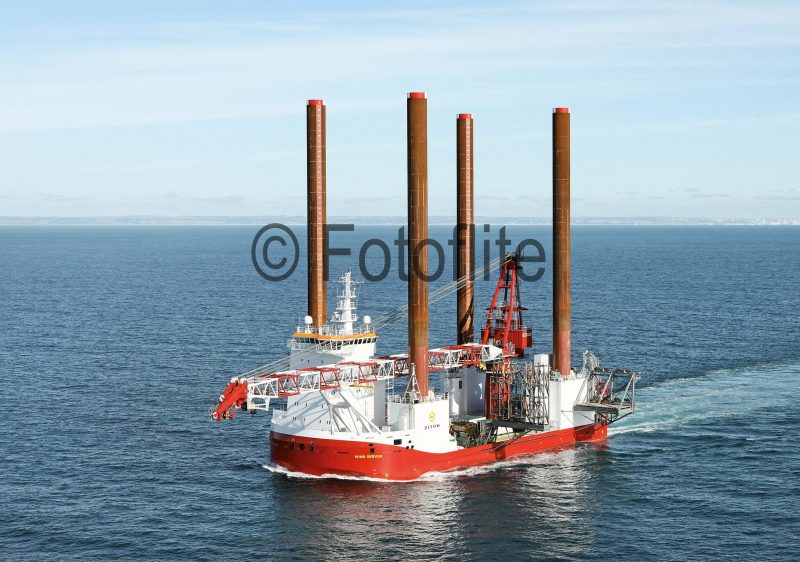
The delivery voyage of Mayflower Resolution took 66 days from China to Falmouth, and she underwent trials in Falmouth Bay, where she was tested for the first time. She was then put to work in February 2004 installing wind turbines at the North Hoyle wind farm on the East Coast for turbine maker Vectis and National Wind Farms, a consortium of Centrica and PowerGen. This contract ended on 23rd March 2004 and she sailed for the Tees and arrived on 30th March. She was due to depart from the Tees on 8th April for Great Yarmouth to install turbines for the Scroby Sands wind farm, but the Mayflower parent company went into liquidation on 31st March with debts of £17.7 million. Deloitte were appointed as administrators and eventually sold her for £12 million to MPI Offshore Ltd. based in Stokesley, North Yorkshire. Mayflower Resolution was then laid up at South Bank on the Tees at times between installation work and became a very familiar sight with her white hull and six tall legs on Teesside.
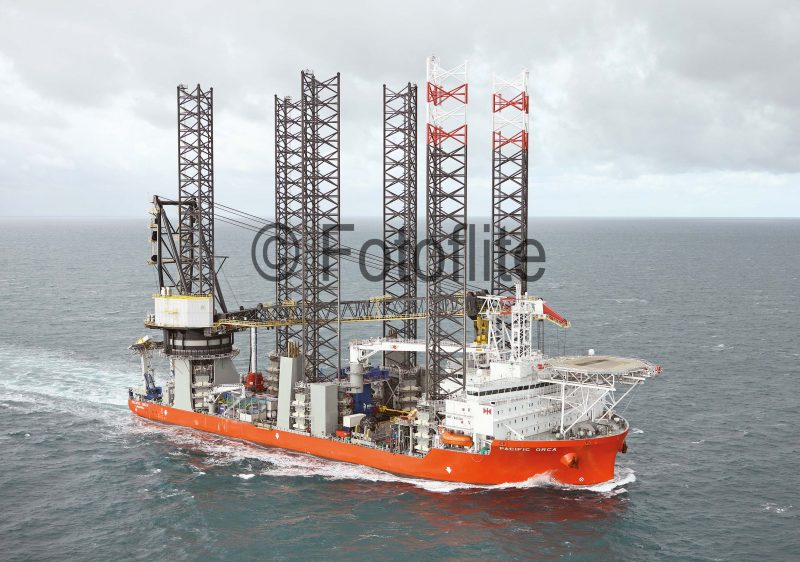
Mayflower Resolution was renamed MPI Resolution in 2004, and was used a year later on the Kentish Flats wind farm to the north of Herne Bay and Whitstable in Kent. This site was operational with thirty Vestas three megawatt turbines to give a combined output of 90 megawatts. The turbines have a rotor diameter of 90 metres, a nacelle height of 70 metres, with 700 metres between each turbine.
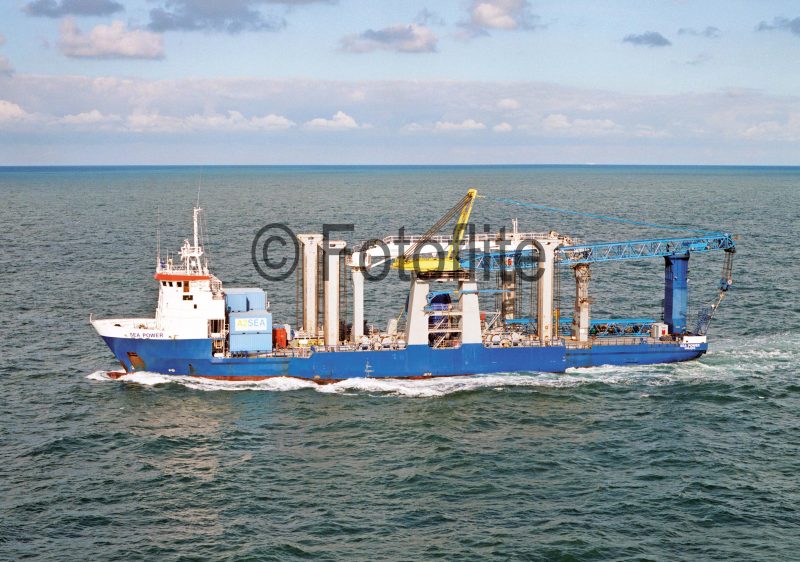
The wind farm is maintained from a base at Whitstable, and in 2014 produced 250 million kilowatt hours of electricity, which is the equivalent to the needs of 60,000 U.K. households. In 2006, MPI Resolution was used for the construction of the Barrow Offshore Wind Farm for Centica and Dong Energy. She was used in 2008 to install turbines in Danish coastal waters off Esbjerg, and also in that year for the installation of turbines at the Lynn and Inner Dowsing wind farms off Lincolnshire for Centrica. She began the installation of eighteen turbines at the Robin Rigg wind farm in the Solway Firth in January 2009, and a year later began the installation of one hundred turbines at the Thanet wind farm off Kent, often transporting nine complete turbines at a time to this Thames Estuary site. She now has a red hull and her design and career has been a great success over fifteen years of pioneering wind turbine installation work.
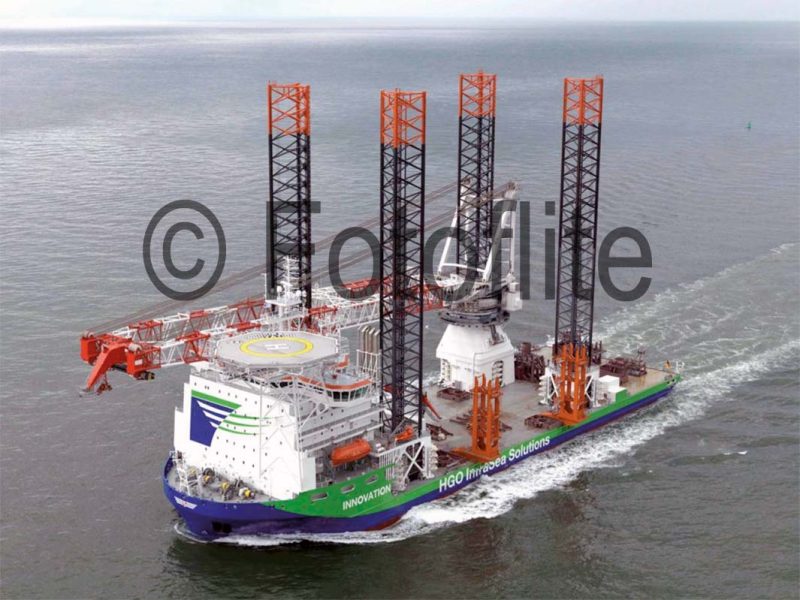
MPI Offshore Ltd.
The contract for two red hulled WTIV sisters, MPI Adventure and MPI Discovery, was placed in 2008 by MPI Offshore Ltd. with a yard in China for the completion of MPI Adventure in March 2011 and MPI Discovery in November 2011. They have dimensions of length 138.5 metres, moulded beam of 40.0 metres, and depth of 10.0 metres with a draft of 5.5 metres. They are equipped with one crane of one thousand tonnes lifting capacity and a smaller crane of fifty tonnes capacity. They are powered by six Rolls Royce eight cylinder four stroke diesel engines driving six generators connected to three electric motors, each of 3,250 kW, and driving three azimuth units to develop a total of 18,924 bhp and a service speed of 12.5 knots. They have a very good vertical jacking speed, extensive deck area, excellent lifting capacity and accommodation, and a DP2 dynamic positioning system. Their owners of MPI Offshore Ltd. became jointly owned by Vroon of Holland and the original MPI management team on 31st March 2006, before the contracts for these two sophisticated WTIV were placed.
These two sister WTIVs have been used on the installation of wind turbines at the large 175 turbine London Array using bases around the Thames Estuary, and on the 27 turbine Tees Bay wind farm of 62 megawatts capacity from a base at Hartlepool. The latter wind farm is arranged in three rows each of nine Siemens turbines one mile off Redcar, with all turbines installed by June 2013 in water depths of up to sixteen metres and with 22 turbines providing power to the National Grid. The monopile foundations were installed by jack-up construction vessel Sea Jack, with the Transition Pieces (TP) installed by jack-up vessel JB114. However, the farm was shut down in January 2014 due to problems with the equipment housings inside the turbines. MPI Adventure later finished her work in Tees Bay from her base at Hartlepool after the problems were rectified. The Tees Bay wind farm is operated by EDF Energy with an anticipated life of 22 years.
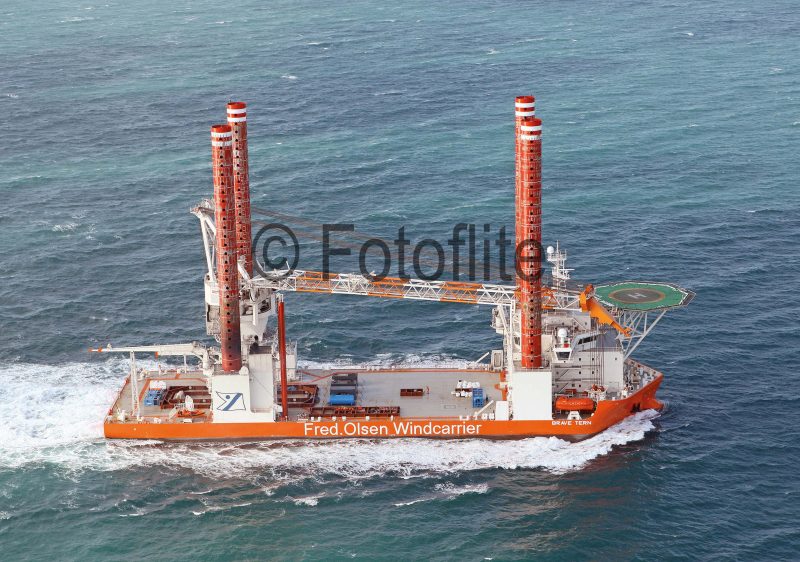
The two sister WTIVs, jointly owned by MPI Offshore Ltd. and Vroon of Holland, were used in 2013 at the 75 Siemens turbines 270 megawatt Lincs wind farm costing one billion pounds and located five miles off Skegness. The offshore electrical sub-station was sub-contracted to McNulty Offshore of South Shields and is connected to the onshore electrical sub-station. The installation bases were at Hull and Great Yarmouth, and the Lincs wind farm is maintained from a base at Grimsby. The two sister WTIVs were recently used in 2017 for the construction of the Rampion Wind Farm off the Sussex coast. The joint vessel owners collaborated by using the offshore Vroon owned supply vessel VOS Prelude to supply fresh water and a dozen IBCs (Intermediate Bulk Containers) in four hours to allow MPI Discovery to quickly recommence her job of erecting offshore wind turbines.
A fourth WTIV was added to the MPI Offshore Ltd. fleet in 2015 with the purchase of Victoria Mathias of 11,730 grt, which had been delivered in December 2011 by the Daewoo Shipbuilding and Marine Engineering yard in South Korea to RWE Seabreeze 1 Gmbh of Germany. She had been launched as Seabreeze 1 on dimensions of length 120.77 metres, moulded beam of 40.0 metres, depth of 8.0 metres, and draft of 4.5 metres. She has a main crane of one thousand tonnes lifting capacity, with a service speed of 7.5 knots from four diesel electric engines driving four generators connected to two electric motors, each of 1,600 kW, and driving twin directional stern propellers. She has two forward thrusters and a DP2 dynamic positioning system for accurate installation of turbines in the North Sea. She installed the wind turbines of the Nordsee Ost OWF nineteen miles off Heligoland before her purchase by MPI and was renamed MPI Enterprise in 2015 and has a blue hull.
A2SEA of Fredericia in Denmark
A2SEA of Fredericia in Denmark was founded in 2000 and has since installed over 1,500 wind turbines and 400 foundations to date. The first WTIVs in the A2SEA fleet were the sisters Sea Power and Sea Energy, in service from the beginning of 2002, and have installed wind turbines on the Horns Reef 1 OWF, Nysted OWF, Scroby Sands OWF, Kentish Flats OWF, Robin Rigg OWF and other wind farms up to 2009. They are of the semi jack-up type and have since been used on some of the thirty wind farms installed by A2SEA in the Irish Sea, North Sea and Baltic Sea. Sea Energy was sold in February 2014 with her crew of thirty including turbine erection personnel transferred to the other WTIVs in the A2SEA fleet. They were accommodated in single cabins with also a rest lounge, mess room, gym and office.
Sea Power and Sea Energy have dimensions of length 91.76 metres, moulded beam of 21.6 metres, and loaded draft of 4.25 metres. They have four legs with a leg length of 32 metres, and a useable deck area of 1,020 square metres. They have a wire jacking system with an elevation speed of 0.7 metres per minute operating in water depths up to 24 metres. They have a main crane of 400 tonnes capacity depending on boom configuration, and an auxiliary Hydralift cargo crane of 27 tonnes capacity, with three complete turbines of between 2.3 megawatts and 3.0 megawatts power output carried on each visit to a wind farm. They have service speeds of 7.8 knots from two main diesel electric engines, each of 1,200 kW, connected to stern azimuth propulsion and steering units.
The two blue hulled WTIV sisters, Sea Installer and Sea Challenger, now comprise the A2SEA fleet. This pair of WTIVs was completed by the COSCO Shipyard Group Co. Ltd. in China in 2012 and March 2014 at a cost of around $150 million each. Their installation cranes have a lift capacity of 900 tonnes with an outreach to a radius of one hundred metres and a slewing circle of 360 degrees. Sea Installer completed the installation of two Siemens six megawatt turbines in January 2013 at the Gunfleet Sands Wind Farm 3 seven kilometres off Clacton on Sea in the Northern Thames Estuary. These twin turbines were adjacent to the Gunfleet Sands 1 and 2 Wind Farms of 48 turbines and 172 megawatt output operated by DONG Energy. Gunfleet Sands 3 began generating power in April 2013, but one blade tip was damaged two months later and was replaced by Sea Installer.
Sea Installer later loaded turbine towers, nacelles and blades at Belfast for installation in Irish Sea wind farms, and was also at the former Swan Hunter Shipbuilders yard at Wallsend in June 2017. The latter was in connection with the prefabrication of five monopiles and yellow transition pieces (TP) in the remaining 750 feet long former Swan Hunter dry dock. These five circular monopiles and TPs, each of three thousand tonnes, fitted neatly into the long dry dock, and were towed out on completion from the Tyne to a position 5.7 kilometres off Blyth and submersed onto the seabed as the gravity based foundations of the Blyth Offshore Wind Farm Demonstration Project. The erection of the wind turbines was done by the Vole au Vent WTIV, owned by Jan de Nul Group of Luxembourg. Balfour Beatty Marine was contracted for the construction of the onshore substation of this EDF Energy wind farm, with Vestas wind turbines and Nexans array and output cabling. The wind farm generates electricity for the National Grid from the five turbines of 41.5 megawatts output, with consent given for a further ten wind turbines.
A2SEA was taken over by GEOSEA of Belgium, part of the DEME Group, in the third quarter of 2017, operators of four WTIVs as well as other heavy lift vessels used in the oil and gas industry. The green and blue hulled Innovation of 22,313 grt is a large WTIV completed by the Crist yard in Gdynia in Poland in August 2012. She is equipped with a large Liebherr crane of 1,500 tonne capacity at an outreach of 31.5 metres and able to slew around a full 360 degrees. She has dimensions of length 188.7 metres, moulded beam of 42.0 metres, depth to main deck of 11.0 metres, and draft of 7.0 metres, with a jacking capacity of 8,000 tonnes, a deck area of 3,600 square feet, and accommodation is provided for 150 crew and turbine erection personnel. She has a transit speed of ten knots and is powered by six diesel electric power plants connected to six generator sets located in three separate compartments and driving four aft azimuth thrusters and three forward tunnel thrusters.
Innovation is owned by HGO InfraSea Solutions (Hochtief/GEOSEA) under the German flag, and has an accurate DP2 dynamic positioning system, with DEME of Belgium also operating three other jack-up DP2 equipped WTIVs in Apollo of 800 tonne lifting capacity, Neptune of 600 tonne lifting capacity, and Goliath of 400 tonne capacity.

These vessels will work with Sea Installer and Sea Challenger on the Galloper OWF, Rentel OWF off Belgium, Burbo Bank Extension OWF, Dudgeon OWF, Race Bank OWF and Hornsea OWF.
Swire Blue Ocean
A pair of WTIV sisters, Pacific Orca and Pacific Osprey, is owned by Swire Pacific Offshore Services (Pty) Ltd. (SPO), with Pacific Orca completed by Samsung Heavy Industries in South Korea in July 2012 and her sister followed at the end of 2012. These are sophisticated and well planned vessels able to carry twelve wind towers as well as nacelles and blades on their decks at any one time to the installation site. They have six legs each of 345 feet, with the vessels having dimensions of length 527.9 feet, moulded beam of 160.7 feet, depth to main deck of 34.1 feet and maximum draft of 19.6 feet. They have an extensive deck area of 43,000 square feet, and very good accommodation for 111 crew and turbine erectors in single cabins. The contract for Pacific Orca was placed in August 2010, and that of Pacific Osprey in March 2011. Pacific Orca was contracted to DONG Energy for the installation of 3.6 megawatt wind turbines in the North Sea, with Pacific Osprey first used in the German North Sea for the installation of wind turbines at the Dan Tysk Offshore Wind Farm.
They were designed by the Knud E. Hansen (KEH) practice of Denmark, and are equipped with two cranes in a main crane and auxiliary crane. The main crane has a primary hoist of 1,200 tonne lifting capacity with two hooks each of 600 tonne lifting capacity at an outreach of 101.7 feet. The auxiliary hoist of the main crane has a maximum lift capacity of 500 tonnes at an outreach of 164 feet. The auxiliary crane has a maximum lifting capacity of 35 tonnes at an outreach of 98 feet, and also has an auxiliary hoist of 25 tonnes capacity at an outreach of 131 feet. The sister WTIVs are operated by Swire Blue Ocean of Copenhagen, with both vessels arriving at this base after the long delivery voyage from South Korea.
Pacific Orca and Pacific Osprey are powered by eight diesel electric generator sets supplied by ABB Technology, with propulsion and manoeuvring by four azimuth stern thrusters, as well as two retractable bow thrusters and two bow tunnel thrusters, and their accurate installation positioning is controlled by a DP2 dynamic control system. The sisters have a service speed of thirteen knots, and can operate on installation work in wind speeds of up to forty miles per hour and wave heights of eight feet, and have a maximum payload of 8,400 tonnes at a draft of 18.0 feet. The six jack-up legs are each of 345 feet in length and can jack-up the deck to a height of 58 feet above the surface of the sea. They have a helicopter landing deck of diameter 72.2 feet, and large capacity tanks for fuel oil, lubricating oil, fresh water, ballast and sewage for long range operations.
Seajacks Group of Great Yarmouth
The Seajacks Group was formed in 2006 with a Head Office in Great Yarmouth, with currently five WTIVs in its fleet, which can also be used in offshore oil industry project work. Seajacks Kracken of 5,186 grt was completed in March 2009 by the Lamprell Energy Ltd. yard at Jebel Ali near Dubai. She was built to a four leg Gusto design with dimensions of length 76.0 metres, moulded beam of 36.0 metres, depth of 6.0 metres and draft of 3.65 metres. She is equipped with a main Gusto crane of 3,000 tonne capacity, and an auxiliary crane of 50 tonnes capacity, with a useable deck area of 900 square metres. She is powered by four sixteen cylinder four stroke Caterpillar diesel engines, each of 2,093 bhp, driving four generators connected to four electric motors and driving four azimuth units with a total power output of 8,156 bhp and a service speed of eight knots.
Seajacks Kracken has been used on wind farm turbine installation work lasting fifteen months for DONG Energy on the Walney OWF off Barrow, and for accommodation and project support work at the Thebaud platform of ExxonMobil off Nova Scotia. She also worked in the North Sea doing well intervention work for TAQA Energy B.V. in the Dutch sector of the North Sea, and by SHELL to prolong the active productive life of their platforms using well stimulation techniques over a three year period.
Seajacks Leviathan is her exact sister completed by the same yard in June 2009, and has been used on the Greater Gabbard offshore wind farm off Harwich on a fifteen month contract with Fluor, loading towers, nacelles and blades at Harwich. She has also been used on the Meerwind Offshore wind farm installing 88 Transition Pieces (TP) and Siemens 3.6 megawatt wind turbines.
The similar Seajacks Hydra has been built to a modified Gusto design by the Lamprell Energy Ltd. yard at Jebel Ali near Dubai, and has been used on the installation of the SylWin Alpha offshore platform and substation.
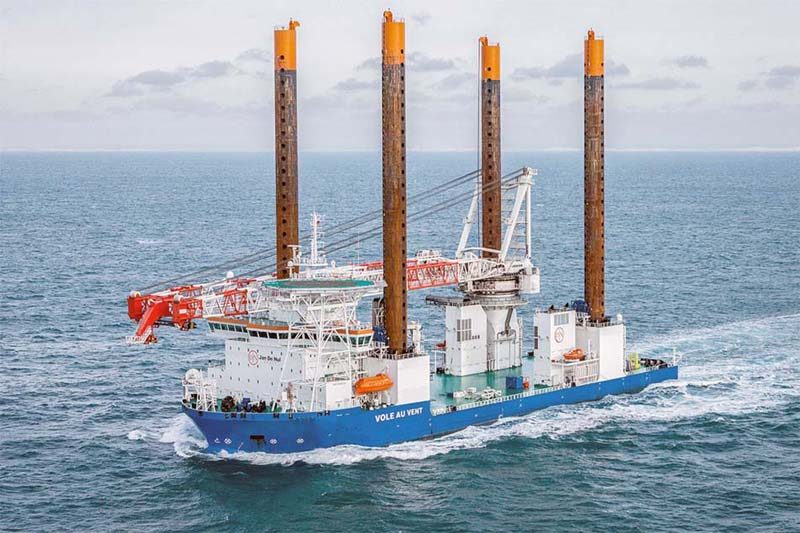
Seajacks Zaratan of 9,704 grt was completed by the same Jebel Ali yard in May 2012 on dimensions of length 81.0 metres, moulded beam of 41.0 metres, depth of 7.0 metres and draft of 5.3 metres. She is equipped with a Gusto main crane of 800 tonnes capacity, and two auxiliary cranes of 12.5 tonnes capacity, and has a useable deck space of two thousand square metres. She is powered by six diesel electric main engines driving four generators, each of 1,600 kW, and connected to six electric motors driving three azimuth propulsion units with a total power output of 11,946 bhp and a service speed of 9.1 knots. She has been used on the Gunfleet Sands OWF, and also on the Meerwind OWF along with Seajacks Leviathan.
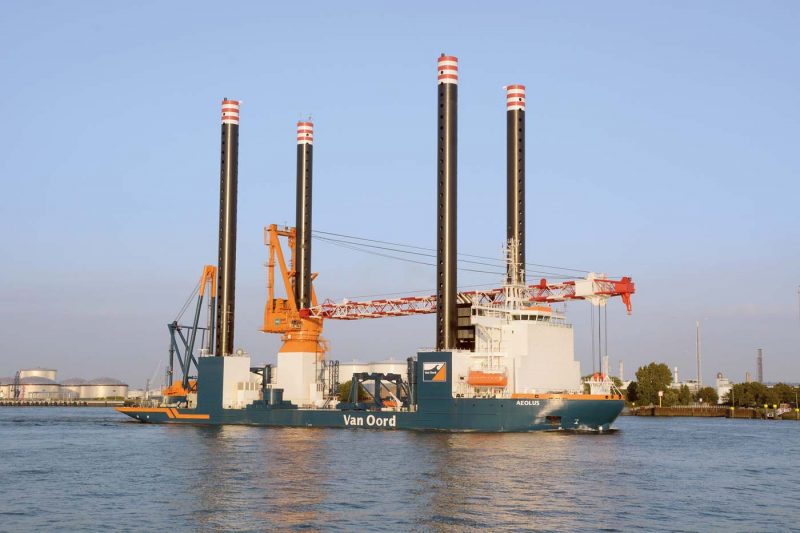
Seajacks Scylla is the latest and very advanced WTIV in the Seajacks fleet, with a large deck area of 4,600 square metres, leg length of 105 metres, and lifting capacity of 1,500 tonnes at maximum radius of 31.5 metres and using a boom of length 105 metres. She was delivered by the Samsung Heavy Industries yard at Geoje Island in South Korea in November 2015, and is able to work in offshore waters up to 65 metres in depth. She has accommodation for 130 personnel in 67 cabins, with extra personnel arriving on the helicopter landing deck of diameter 22.2 metres. She has a service speed of twelve knots from three stern azimuth propulsion thrusters and three forward retractable thrusters, with her accurate position controlled by a DP2 dynamic positioning system. The hull has dimensions of length 139.0 metres, wide moulded beam of 50.0 metres, depth of 11.0 metres, and draft of 6.0 metres. The jacking system is of the rack and pinion type with electric drive and an elevation speed of 0.8 metre per minute. This is sufficient for a jacking capacity of 7,680 tonnes per leg, and a holding capacity of 14,000 tonnes per leg. There is a more than adequate survival capacity in twin 130 person lifeboats located on the port and starboard sides, double the maximum personnel working on the vessel.
Fred. Olsen Windcarrier A/S
This famous Oslo based shipowner operate two sister WTIVs, Brave Tern and Bold Tern, completed during 2012/13 by the Lamprell Energy Ltd. yard at Jebel Ali near Dubai, plus a fleet of seven small, fast crew transfer vessels. The WTIVs are registered at Valetta and have four legs with a centrally mounted main Gusto 800 tonne crane at 26.0 metres outreach and able to slew through 360 degrees. There are also two small deck cranes of twenty tonnes capacity, and another of six tonnes capacity. They have helidecks with eighty crew and turbine erection personnel accommodated in 56 cabins. They have dimensions of length 132.0 metres, moulded beam of 39.0 metres, depth to main deck of 9.0 metres, and loaded draft of 4.25 metres. They can carry a payload of 7,600 tonnes on their extensive deck areas, and have continuous hydraulic double acting jacking systems with 5,300 tonnes jacking capacity per leg and 9,000 tonnes holding capacity per leg. They have service speeds of twelve knots from three Voith Schneider aft mounted azimuth units each of 3,800 kW, and three Wartsila forward tunnel mounted thrusters each of 1,750 kW. They have DP2 accurate positioning systems for use in pinpoint position holding during installation of wind turbines, and can operate in water depths from 5.5 to 60.0 metres.
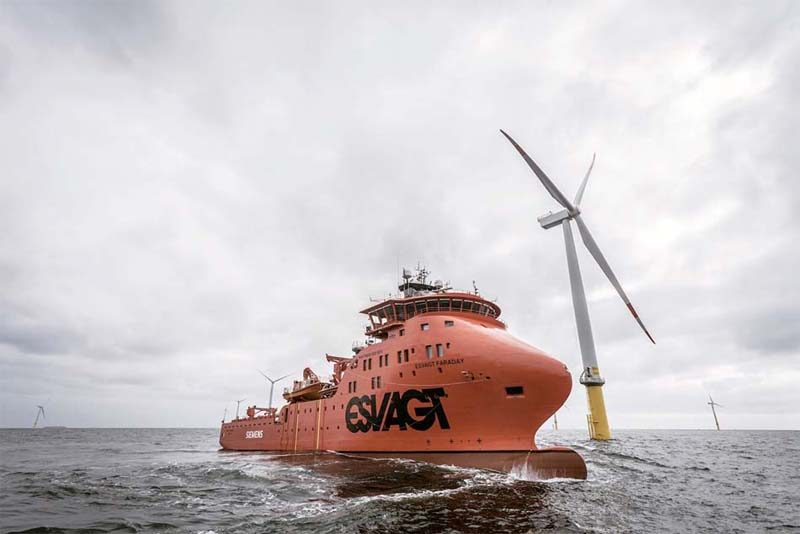
Further WTIVs and Wind Turbine Repair Vessels
Aeolus was completed as a WTIV in 2014 for Van Oord of Holland with Pieter van Oord as Chief Executive Officer. The company has a very long history of dredging and land reclamation dating back to 1850, with the Palm Jumeirah artificial island at Dubai as one of their better known land reclamation projects. Aeolus has a very advanced jacking system on her four giant legs, each measuring 85 metres in length. The main crane has a lifting capacity of 990 tonnes, and she began working after delivery on the Eneco Luchterduinen OWF project off Holland, and has also repaired many turbines on the Princess Amalia OWF off Holland, which was commissioned in 2006.
The Vole au Vent WTIV was completed in December 2013 by the Crist yard in Gydnia in Poland for the Jan de Nul Group of Luxemburg. She has a blue hull, large deck space of 3,400 square metres, a main Liebherr crane of 1,500 tonnes capacity at seventeen metres outreach, and four legs that enable her to work in water depths of up to fifty metres. She has hull dimensions of length 140.4 metres, moulded beam of 41.0 metres, depth to main deck of 9.5 metres and a maximum draft of 6.3 metres. She has accommodation for ninety personnel, a large diameter helideck, a maximum payload of 6,500 tonnes, a double ring jacking system, DP2 dynamic positioning system, and a service speed of twelve knots from six diesel engine generator sets of 4,000 kilowatts at 600 rpm driving four azimuth propulsion thrusters of 2,600 kW, and three bow tunnel thrusters of 2,500 kW. She is also designed to work installing foundations, tidal current turbines, wave energy generators, meteorological masts, and oil and gas underwater construction projects.
Wind Server of 5,700 grt is a WTIV and wind turbine repair vessel that can repair faults e.g. in the nacelle housing or governor cut-outs due to ‘racing’ in very strong winds above the designed wind speed of a single turbine. She has four legs, a red hull and a red main crane and flies the red and white Danish flag, with dimensions of length 78.0 metres, moulded beam of 32.0 metres, and draft of 5.3 metres. She has a payload of 1,500 tonnes and was completed in 2014, and has worked on the Lincs, Burbo Bank, West of Duddon Sands, and Tees Bay OWFs, the latter in August 2017 when repairing turbine 22 of the 27 turbine array. She has also repaired turbines on Continental wind farms out of bases at Borkum, Eemshaven, Esbjerg, Warnemunde (Rostock) and Nordeney.
The German WTIV Sea Lift 1 of 7,962 grt is operated by Harren & Partner of Bremen for owner Ocean Breeze Energy, and was completed in March 2010 by the Western Shipyard (BLRT Group) in Klaipeda, Lithuania. She has dimensions of length 93.86 metres, moulded beam of 36.0 metres and loaded draft of 5.5 metres, with a Gusto MSC main crane of 500 tonnes capacity at an outreach of sixty metres. She has four legs and a hydraulic jacking system and can work in water depths up to 45 metres. She has accommodation for fifty crew and turbine erection personnel, and has worked on wind farms in the eastern North Sea and western Baltic Sea.
There are wind farms being installed in coastal waters of the South China Sea and the Far East, with one WTIV being used by Teras Pneuma (Pte) Ltd. of Singapore called Ocean Tec 1. She was completed in September 2013 by the Nantong Jiaolong Heavy Industries yard in China on dimensions of length 75.75 metres, moulded beam of 38.0 metres, depth to main deck of 7.0 metres, and draft of 4.0 metres. She has four legs of length 95 metres, each of diameter 3.66 metres, and is equipped with a main crane of 600 tonnes capacity at an outreach of 17 to 22 metres. She has a working deck area of 1,400 square metres, an electric rack and pinion jacking system, and is powered by four diesel engines connected to three azimuth propulsion and steering units of 1,000 kW capacity, together with three bow tunnel thrusters for manoeuvring. The crew and turbine erection personnel number 58 with supplies and crew changes performed via a helideck.
Postscript
The thirty examples of WTIVs described in this article in service in 2018 represent the very latest in the new technology of wind farm construction. However, if one includes jack-up barges, and multi-purpose vessels that usually work in the offshore oil and gas and civil engineering markets, the total number of vessels that are capable of wind farm work is seventy.
The wind turbine installation market has grown at a fast rate from 2008, and there will be thirty WTIVs in commission for dedicated use on wind farms by 2020.
Neptun Ship Design (NSD) of Germany has come up with some innovative designs for future WTIVs for the decade after 2020 when deeper water, longer distances from maintenance bases, and taller turbines of higher megawatt capacity will be the new challenges. Code named Blue Amber, Blue Achat and Blue Azurit, these future WTIVs will be able to install wind turbines in water deeper than sixty metres, and will have huge main cranes of at least 2,000 tonne capacity at an outreach of 45 metres as standard.
Another design has been prepared by Bergen based shipbuilder and foundation specialist, NorWind, known as the Norwind Installer for an advanced X-bow offshore wind turbine foundation installer of the future.
The current WTIVs have their legs firmly lowered down on to the seabed and then jack themselves up her legs above the surface of the sea to gain height, but this method can only be used in shallow water.
The quest for more renewable and alternative energy sources of all types will continue for a very long period into the future, with wind and solar power leading the way, in order to lessen the dependence on fossil fuels.
The WTIV vessel Owtis of W3GMarine has been launched this year with 4,500 square metres of deck space and a main crane of 1,500 tonnes lift capacity, while VuykWV of Vuyk Engineering is scheduled for launch in 2020 with a main crane of 3,000 tonnes capacity and 4,700 square metres of deck space.

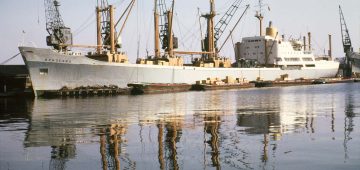


Comments
Sorry, comments are closed for this item